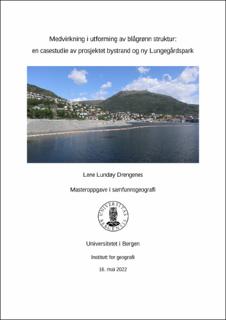| dc.contributor.author | Drengenes, Lene Lundøy | |
| dc.date.accessioned | 2022-06-18T00:12:25Z | |
| dc.date.available | 2022-06-18T00:12:25Z | |
| dc.date.issued | 2022-05-16 | |
| dc.date.submitted | 2022-06-17T22:00:32Z | |
| dc.identifier.uri | https://hdl.handle.net/11250/2999394 | |
| dc.description | Revised version. Minor formatting errors corrected. | |
| dc.description.abstract | Innen diskursen om en bærekraftig urban utvikling, ser byer i økt grad til blågrønn struktur for å håndtere flere samfunnsutfordringer. Blågrønn struktur blir ansett som et miljøgode med de mange økosystemtjenestene som følger med, som karbonlagring, renere luft, filtrering av vann og rekreasjonsmuligheter. De blågrønne rommene som blågrønn struktur legger til rette for kan være omstridte, med de mange meningene og interessene som er knyttet til dem. I tillegg kan fordelingen og tilgangen til blågrønne rom variere for ulike målgrupper. I noen tilfeller kan utformingen av et nytt blågrønt rom føre til et «grønt paradoks», hvor innbyggere blir omplassert til mindre attraktive områder som følge av transformasjonen av området. Det har i økende grad blitt mer fokus på medvirkning i utforming av blågrønn struktur. Denne masteroppgaven har dermed som formål å undersøke målsetningen om medvirkning i utforming av blågrønn struktur og hva som skjer i praksis. Problemstillingen tar for seg hvilke utfordringer som er til stede for kommunen ved medvirkning i prosjektet bystrand og ny Lungegårdspark. Det teoretiske rammeverket tar utgangspunkt i den kommunikative vendingen innen planlegging med et relasjonelt perspektiv for medvirkning. Konseptet for naturbaserte løsninger viser til utfordringer og muligheter for medvirkning i prosjekt med blågrønn struktur. Til slutt er Arnstein (1969) sin deltakelsesstige blitt anvendt som et analytisk verktøy for å vurdere de ulike nivåene av innflytelse i prosjektet. Masteroppgaven er basert på en kvalitativ metode og de empiriske funnene er et resultat av 15 semi-strukturerte intervju sammen med sekundærdata. Oppgaven har bidratt med økt kunnskap om rollen til medvirkning i utformingen av blågrønn struktur. Det er identifisert flere utfordringer for å tilrettelegge for medvirkning i prosjektet. Utfordringene er knyttet til et medvirkningsparadoks, forventningsavklaring, geografisk utstrekning, medvirkningstretthet og muligheten for deliberasjon. Oppgaven avsluttes med noen refleksjoner for hva resultatet kan bidra med i medvirkningspraksisen til kommuner i fremtidige prosjekt med blågrønn struktur. | |
| dc.description.abstract | Within the discourse of a sustainable urban development, cities are increasingly looking to blue-green infrastructure to deal with several societal challenges. Blue-green infrastructure is considered an environmental good, with the many ecosystem services that come with it, such as carbon storage, cleaner air, water filtration and recreational opportunities. The blue green space that blue green infrastructure facilitates can be controversial, with the many opinions and interests associated with them. In addition, the distribution and access to blue green spaces may vary for different stakeholders. In some cases, the design of a new blue green space can lead to a “green paradox”, where residents are relocated to less attractive areas as a result of the transformation of the area. There has been an increased focus on participation in the design of blue green infrastructure. The purpose of this master thesis is therefore to investigate the goal of participation in the design of blue green infrastructure and what happens in practice. The problem statement addresses the challenges that are present for the municipality when facilitating for participation in the city beach and new Lungegårdspark project. The theoretical framework is based on the communicative turn within planning with a relation perspective on participation. The concept of nature-based solutions points to existing challenges and opportunities for participation in projects with blue green infrastructure. Finally, Arnstein’s (1969) participation ladder has been used as an analytical tool to assess the various levels of influence in the project. The master thesis is based on a qualitative method and the empirical findings are the result of 15 semi-structured interviews and secondary data. The present study has contributed with knowledge about the role of participation in the design of blue green infrastructure. Several challenges have been identified for the municipality to facilitate for participation in the project. The challenges are related to a participation paradox, expectations for participation, geographical extent, participation fatigue and the possibility for deliberation. The thesis ends with some reflections on what the result can contribute to the participation practice for municipalities in future projects with blue green infrastructure. | |
| dc.language.iso | nob | |
| dc.publisher | The University of Bergen | |
| dc.rights | Copyright the Author. All rights reserved | |
| dc.title | Medvirkning i utforming av blågrønn struktur: en casestudie av prosjektet bystrand og ny Lungegårdspark | |
| dc.title.alternative | Participation in the design of blue-green infrastructure: a case study of the city beach and new Lungegårdspark project | |
| dc.type | Master thesis | |
| dc.date.updated | 2022-06-17T22:00:32Z | |
| dc.rights.holder | Copyright the Author. All rights reserved | |
| dc.description.degree | Masteroppgave i geografi | |
| dc.description.localcode | GEO350 | |
| dc.description.localcode | MASV-GEOG | |
| dc.description.localcode | MASV-PHYG | |
| dc.description.localcode | MPGEOGR | |
| dc.description.localcode | MASV-MEHA | |
| dc.subject.nus | 733111 | |
| fs.subjectcode | GEO350 | |
| fs.unitcode | 15-41-0 | |
